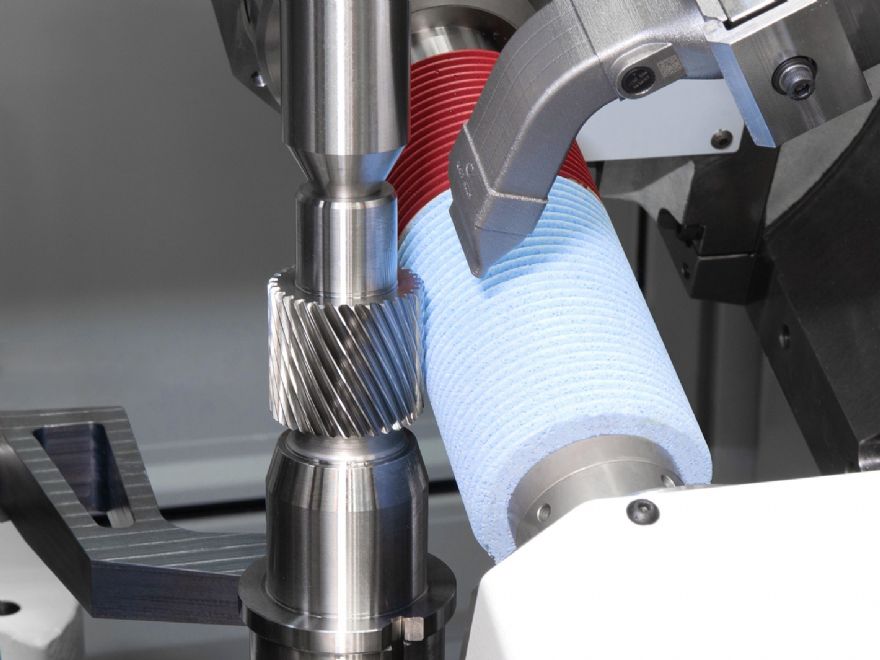
Gearboxes used in electric vehicles (EVs) are not only designed for high speeds and high torques – but they are also very compact. This is not only true for the automotive sector but also innovative applications such as e-bikes. These small but high powered and electrically driven gearboxes inspire design engineers to come up with more creative solutions. Offering the gear manufacturing technology manufactured by
Kapp Niles, the
Engineering Technology Group (ETG), based in Wellesbourne, offers UK manufacturers industry-leading solutions for producing EVs and e-bike gearboxes.
In many cases, gearboxes comprise small components with interfering contours that pose new challenges during production. When it comes to the hard finishing of the gear teeth, the process-related potential goes hand-in-hand with high production costs. The most economical option is generating gear grinding. However, not all generating gear grinding machines are suitable for the production of compact components.
Transmission manufacturing does not have to be re-invented to become suitable for the e-mobility sector, but there are some new challenges to be faced. These include, above all, the high power density and the compact installation space in which the entire power train must be accommodated. At the same time, the new areas of application are opening up new sales opportunities, such as e-bikes, which have recently grown in popularity.
This benefits the manufacturers and their suppliers — gearbox manufacturers among them. However, be it two or four wheels, the drive technology is sophisticated. The focus is on the required flank load capacities and the noise behaviour of the gear teeth due to the boundary conditions imposed by the electric drive motor, an almost constant high torque over the speed range of 0 to 18,000rev/min.
However, new challenges are not only limited to the machined parts but also directly affect the manufacturing process. Due to the compact nature of the gearbox, an increasing number of components with interfering contours emerge in the design. Large tools with standard dimensions of the worm grinding wheel quickly and literally meet their limits. To avoid having to resort to more time-consuming and thus more expensive processes, the tools must also be miniaturised.
Identify and overcome boundariesUp to now, the hard finishing of gears with interfering contours has mainly been accomplished by discontinuous profile grinding or gear honing. Compared to continuous generating grinding, both processes have their drawbacks in terms of productivity, economic efficiency or quality consistency. The problem is that the common grinding worms measuring 300mm diameter are too large to handle components with interfering contours.
At the same time, smaller tools require higher speeds to achieve high cutting speeds, but previously implemented machine concepts were not designed for the high dynamic requirements regarding tool and workpiece driving. However, new types of high-speed spindles in combination with a dynamic direct drive of the workpiece axis can offer a solution.
This enables manufacturers to exploit the advantages provided by generating grinding – a process that features shorter machining times, lower tool costs and a very high level of quality consistency.
The right machines to cover the requirementsGermany-based machine tool manufacturer Kapp Niles specialises in system solutions for grinding gears. Available in the UK via ETG, the manufacturer offers two machine types for meeting customer requirements. Both series are equipped with high-efficiency drives for the tools (25,000rev/min) and the workpieces (5,000rev/min). The KNG350 flex HS has a conventional design featuring one workpiece drive. The machine is available in two versions, one for miniature and small lot sizes with manual loading and for higher volumes, an automated version is available with an integrated ring loader. Workpieces up to 350mm in diameter can be processed using this machine.
The machine features short set-up times that are possible through the use of intelligent components and unique ergonomics. For large-scale production, it is worth taking a closer look at the productivity times of machines pre-set by design.
Meanwhile, the KX TWIN series with two workpiece drives and a loading and unloading process that is performed in parallel to the actual grinding operation offers further potential for the reduction of non-productive times. The in-line centrifugation of the components directly in the machine enables compliance with the ‘Clean Factory’ approach across all known automation concepts.
In addition to the machining of compact components with interfering contours, the following additional challenges arise when it comes to the production of e-gearboxes: the noise behaviour of the gearbox and the gear teeth has been increasingly gaining in its significance.
As the load-bearing capacity of gear teeth is being continuously enhanced, the topology of the tooth flank is increasingly moving into focus. During the grinding process, a natural interlocking occurs on the machined tooth flanks. With the innovative KN grind software, this phenomenon not only can be simulated in advance - but can also be completely eliminated or precisely manipulated.